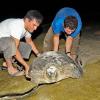Satellite telemetry on sea turtles in Kuwait
Satellite telemetry on sea turtles in Kuwait - challenging and worth it
By Nancy Papathanasopoulou
They are here once again. The Kuwait Turtle Conservation Project (KTCP), sponsored by TOTAL Foundation and TOTAL Kuwait and in cooperation with the Voluntary Work Center Kuwait and The Scientific Center Kuwait, was on Umm Al-Maradim island on the 4th of May 2010 witnessing fresh tracks of two different Hawksbill turtles (Eretmochelys imbricata). Like last year, KTCP researchers and volunteers will form a united and motivated expedition team with the mission of finding those turtles and carrying out a satellite telemetry project.
Satellite telemetry involves following an object on the Earth with the use of orbiting satellites. Researchers use this technology to track the migratory patterns of wild animals throughout their natural habitats. It is used for terrestrial, as well as marine animals and it has revealed a great amount of secrets on migratory avifauna all over the world.
In the case of sea turtles, satellite telemetry allows researchers to obtain up-to-date location points every time the sea turtle rises to the surface of the water for air.
A Platform Terminal Transmitter (PTT) is attached to the back of a sea turtle. The PTT sends a signal full of information to an orbiting satellite. The satellite then re-transmits the data to a receiving station on Earth. Researchers can then access this information through a computer.
Satellite transmitters can be attached several different ways. For hard-shell turtles, such as Green (Chelonia mydas) and Hawksbills, which nest in Kuwait, the Marine Epoxy Method or the Fiberglass and Resin Method are used. Both methods are safe for the turtles, neither hurting their shells nor inhibiting their movements in the ocean. Transmitters are designed to safely fall off the turtles after about a year and a half. Leatherback turtles, which lack a hard shell, require a different method because of the texture of their carapace (shell). A harness that wraps around the shell is sometimes used to secure a transmitter. Recently, however, the use of a harness is being doubted as too stressful for the turtle and in,hibitive of its free movements through the seas and oceans of the planet.
How does satellite telemetry work?
The small, low wattage PTTs attached to the turtles are controlled by a micro-processor, which is programmed by a computer before it is attached. The program tells the micro-processor how to store information and when to transmit the information to the satellites. Polar orbiting satellites are currently used for tracking animals. The satellites are operated by the U.S. National Oceanic and Atmospheric Organization (NOAA) and are the same satellites used to monitor global weather patterns. Attached to these satellites are special instruments operated by a French company, ARGOS CLS. These special instruments are designed to listen for transmitters like those we place on turtles and to determine where those transmitters are located. While such a task would seem simple, it is not. Each satellite circles the earth every 101 minutes and so it is only over any one place on the planet for about 10 minutes. At the equator, this means that the satellites make about 6-8 passes per day for 10 minutes each. For the satellite to determine the location of the transmitter it takes about 3-5 minutes, and the transmitter must be on the surface to be detected. This means that a turtle must come up for air for at least 3 minutes to be detected by the passing satellite.
The challenges
In Kuwait, sea turtles are scarce both on Garooh and Umm Al-Maradim’s nesting beaches but also in the water. Finding individuals which would be healthy and suitable for satellite telemetry has not been easy. Temperature and humidity factors produced functional problems with the use of a specific type of Epoxy glue, so another, more heat and humidity tolerant type is to be used this year.
Starting end of May 2010, the KTCP shall be on the islands again, waiting, determined to help reveal the whereabouts, habits and migrations as well as many other secrets that the Kuwait sea turtles have kept for thousands, maybe millions of years.


